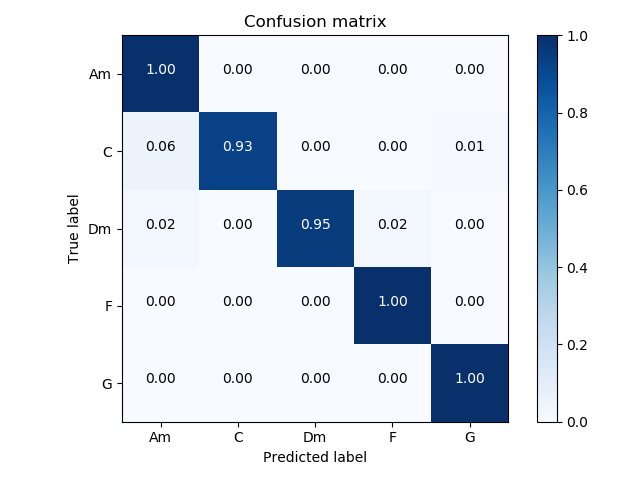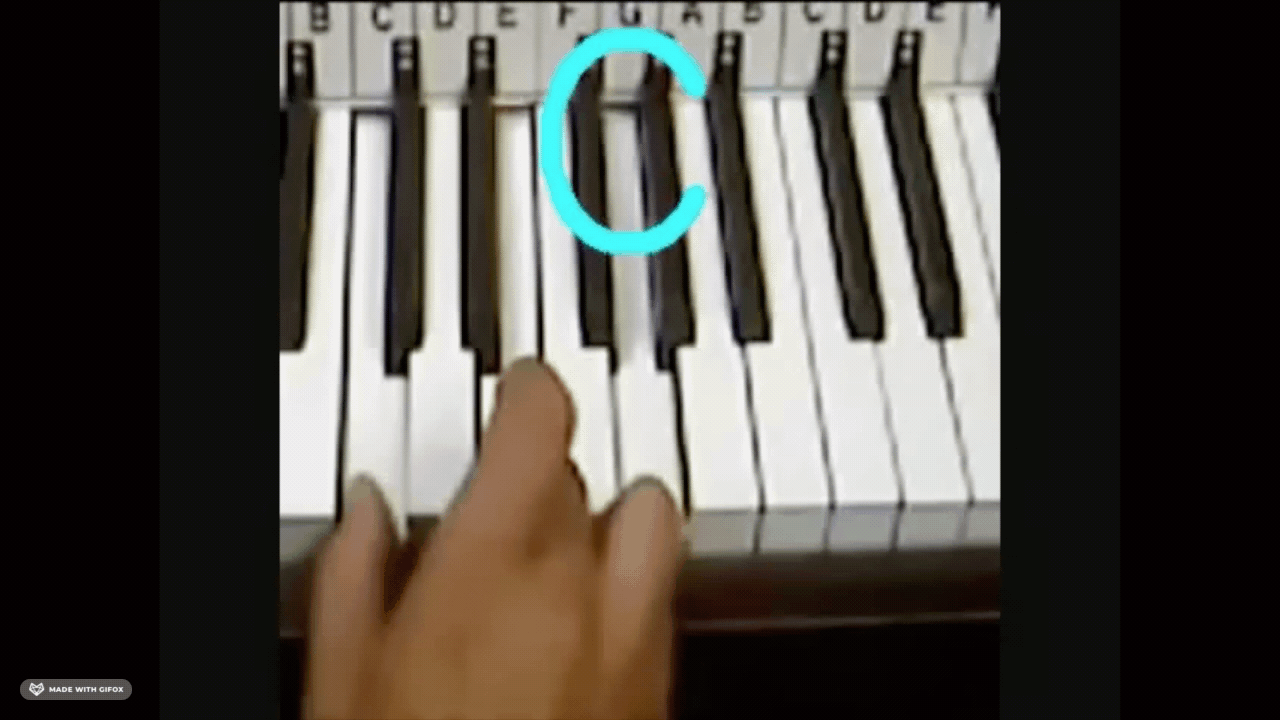The goal of this project was to create a piano chord classifier based on images of hands playing the piano.
Deep learning has been used to classify chords based on audio input, but there aren't many chord identifiers based on images! A chord image classifier could have many use cases such as helping hearing impaired musicians or supporting virtual learning, and could be a precursor to musical transcription based on a video input.
With a "little help from my friends", I generated and self-labeled images of five chords: C, F, Am, Dm, and G. The images came from 12 people and 8 unique pianos, included both left and right hands and multiple fingerings. There were approximately 15 images generated per person, per class. An assortment of the images is shown below.
I randomly split the raw images into training and validation sets, and then performed augmentation on the training set using keras' ImageDataGenerator. This created 20 additional images per raw training image, by randomly performing the following transformations: rotation, shearing, dilation, and translations.
I chose to use the Xception architecture, initialized to the ImageNet weights <link to paper>. This allowed me to leverage prior learning to accommodate a smaller sample size. The only change made to the original Xception architecture was the output layer, which was set to a 5-neuron softmax-activated output.
The figure below outlines Xception's structure. Colors indicate that the weights were adjusted from the original ImageNet weights. The final model and associated weights is saved as best_model_5chords.hdf5 within the CovNet_logs folder.
Xception Model Structure:
During the training process, layers were sequentially unfrozen and the learning rate and/or optimizer was adjusted. Early stopping was used to monitor validation loss during each training iteration, and the loss function was set to categorical cross-entropy. The model started as a 3-chord classifier, but was later changed to a 5-chord classifier after promising results. When switching to the 5-chord classifier, the weights from the best 3-chord classifier were used.
initial tuning: 3-chord classifier
- Outer layer - 3 class, softmax: SGD(lr = 0.2), 10 epochs
- Block 14: SGD(lr=0.01, momentum = 0.9, decay = 0.001)
- Block 13: SGD(lr=0.01, momentum = 0.9, decay = 0.001)
- Block 12: SGD(lr=0.001, momentum = 0.9, decay = 0.001)
- Block 12: Adam(lr=0.001, beta_1 = 0.9, beta_2 = 0.999)
- Block 11: Adam(lr=0.0001, beta_1 = 0.9, beta_2 = 0.999)
- Block 10: Adam(lr=0.0001, beta_1 = 0.9, beta_2 = 0.999)
changed to a 5-chord classifier
- Outer layer - 5 class, softmax: SGD(lr = 0.2), 10 epochs
- Block 14: Adam(lr=0.001, beta_1 = 0.9, beta_2 = 0.999)
- Block 10+: Adam(lr=0.0001, beta_1 = 0.9, beta_2 = 0.999)
I chose to monitor validation accuracy, as I cared most about my model being able to correctly classify the chords. The graph below outlines the validation accuracy with each training iteration. We see the biggest jump in accuracy during the 3rd iteration, after unfreezing block 14. The model ended with a validation accuracy of 95.8%.
The figure below shows a normalized confusion matrix for the 5 chord classes. The model had the lowest recall for chords C and Dm, at 92% and 93% respectively. The classifier incorrectly labeled 3% of the true C chords as Am, which is interesting because Am is the relative minor of C major. Their chords share 2 out of 3 keys! Similarly, the model would label true Dm chords as F (5% of the time), and Dm is the relative minor of F major!
I used OpenCV to predict chords based on video frames. The three gifs below show these prediction outputs (at 4x the original speed), and the original output videos can be found in the images/videos/predictions folder.
Clip of me! The model correctly labels each chord. The model's prediction fluctuates when keys are not being pressed.
Another clip of me! The model incorrectly labels the Dm chord (2nd in the loop) as a F. Dm had one of the lowest recalls, per the confusion matrix above (92%). Clip of youtuber! The model performs well on this youtube clip. PredictionsOne concern I had was that my model had only seen a small number of hands and pianos, and of those hands, the majority were white. Therefore, it was important to me that I could test my model on additional images I could find online. This task was actually very difficult; surprisingly, many pictures of piano chords don't actually have hands in them! Additionally, the ones that do have hands in them are not always playing a triad (1-3-5 chords), which is what I was identifying in my model. The pictures below show un-seen hands, pulled from google and/or provided by additional friends. Of these fifteen pictures, five were incorrectly classified, which means the true accuracy of my model is likely much lower than what was presented.
These initial findings indicate that there is sampling bias in my data and I have a lot more work to do in diversifying and expanding the training data!
A deep CNN is able to distinguish between 5 different chords with high accuracy! This model is a great starting point for further exploring chord classifiers based on images and/or videos.
Diversify and Expand the Dataset It is clear that we need a more robust dataset in order to get a better idea of the model's performance.
Multi-label Classification: I think that a multi-label classifier that identifies which keys are being pressed would be more interesting than a chord classifier. The reason it was so hard to find pictures of these simple chords is that most people don't play them! Instead, musicians invert chords, add notes, and play with two hands. Creating a multi-label classifier would better align with what musicians actually play, and would be a better pre-cursor to transcription from a video.







